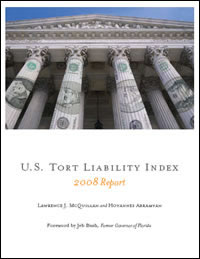The U.S. Tort Liability Index: 2008 Report measures the best and worst tort systems in America. The Pacific Research Institute developed the Index as a tool for governors and state legislators to assess their tort systems and to enact laws that will improve the business climates of their states. The study helps predict the winners and losers in the race for jobs and business investment. It is also useful for business leaders who are deciding where to start a new business, build a new plant, expand operations, introduce a new product, or hire more employees. States that rank worse in the study are less likely to lead in these areas.
An efficient tort system is an important part of a thriving free-enterprise economy. It ensures that firms have proper incentives to produce safe products in a safe environment, and that truly injured people are fully compensated. An efficient tort system results in greater trust among market participants, leading to more trading, and eventually a higher standard of living for individuals in the society. An efficient tort system benefits all.
A poor tort system, on the other hand, imposes excessive costs on society, not the least of which is foregone production of goods and services. There is growing evidence that U.S. tort costs are far greater than other countries’ costs and that much of the difference is due to excessive litigation and lawsuit abuse. All of us shoulder the burden of an excessively expensive and inefficient tort liability system through higher prices, lower wages, decreased returns on investments in capital and land, restricted access to health care, and less innovation. Businesses that spend more money each year on liability insurance have less money available for research and development or for health benefits for their employees. All of us pay the price, whether we realize it or not.

